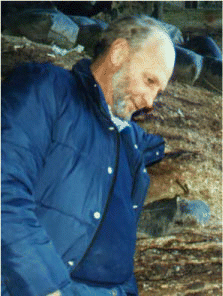
Using the flat end of a stern brush, Hilary Deacon whisked away sediment to expose segments lying by a fireplace where they had been abandoned more than 60,000 years ago. With deft movements, he and his sharp trowel unravelled complex stratigraphy. He discerned subtle colours; his fingertips sensed minute textural differences. His students were mesmerised by the way that he talked to long columns of strata and how such monologues clarified his thoughts. He saw in ‘carbonised partings’ (black stringers of burnt organic material), a promise of geophyte exploitation implying that early hunter-gatherers farmed with fire.
As these preliminary remarks indicate, Hilary Deacon, the father of multidisciplinary archaeology in South Africa, who died on 25 May 2010, was a superb excavator and field researcher who could read the landscape and identify with earth, rocks and the rich fynbos vegetation of the Cape; he sought relationships between these and the hunter-gatherers for whom they were once important. He excavated many Cape sites. From the Later Stone Age, there were Scott's Cave, Wilton Large Rock Shelter, Melkhoutboom Cave, Springs Rock Shelter and Matjes River Shelter. Sites with both Later Stone Age and Middle Stone Age occupations included Highlands Rock Shelter, Kangkara Cave, Paardeberg Cave, Boomplaas Cave A and B, and Klasies Main site. He excavated Howiesons Poort Shelter, the type-site for the Middle Stone Age industry that has fascinated archaeologists more than any other and also dug the Earlier Stone Age sites of Amanzi Springs, Doornlaagte Pan (with Revil Mason) and Elandsfontein (Hopefield). All of these excavations were undertaken using the most advanced methods of the time, some of them innovations of Hilary's making. His research projects were undertaken, first, from the Albany Museum in Grahamstown, where he became a Professional Officer (Archaeology) in 1963 and then Deputy Director and, secondly, from the University of Stellenbosch, where he was appointed Senior Lecturer in Archaeology in 1971 and subsequently Professor of Archaeology in 1979.
In his role as mentor, Hilary's work ethic motivated students and inspired them to be productive. With their interests always foremost, he encouraged them to develop skills that would make them sought after by employers when they left the nurturing lecture halls of Stellenbosch. He also taught the value of assembling multi-stranded evidence for resolving archaeological problems. He was the first archaeologist in South Africa to set up facilities for studying charcoal from ancient firewood, seeds and geophytes, so that past vegetation communities could be identified, and he also instigated research into the palaeoecology of the fynbos. His palaeobotanical research was instrumental in demonstrating dramatic environmental change in the Cape during shifts between marine isotope stages, but he also explored additional avenues of environmental research, including isotope analysis, sea-level changes and geoarchaeology. Some of Hilary's students were encouraged to study micromammals, macrofauna, or the taphonomy of bone. Others researched lithic technology, use-wear analysis or spatial patterning because, in his later years, Hilary became increasingly fascinated by the behavioural implications of his research. His work on cannibalism at Klasies continues to fascinate scholars world-wide. He was deeply committed to training South Africans to study and preserve South Africa's heritage and devised a succession plan that involved passing the trowel to his younger team members when he was no longer able to work in the field. His PhD graduates are Margaret Avery, James Brink, Simon Hall, Hermanus Opperman and Sarah Wurz. Other practising archaeologists who benefited from his mentorship at Stellenbosch include Johan Binneman, Jaco Boshoff, Vera Geleijnse, Lynn Harris, Zoë Henderson, Zenobia Jacobs, Mary Leslie, Peter Mitchell, Frans Prins, Renee Rust, Catherine Snel, Joané Swart, Madelon Tusenius, Liezel van Pletzen, Nick Walker and Lita Webley. Hilary's programme of skills development also extended beyond students to technicians at the university, for example Booi Adams who, sadly, predeceased Hilary in 2008.
Hilary's influence was felt overseas as much as at home. He was frequently invited to give prestigious lectures or conference papers, and to accept visiting teaching or research positions abroad. In 1978 he was Visiting Professor at the University of Chicago, in 1984 Visiting Fellow at the Australian National University, and in 1986 a Visiting Lecturer at the University of California-Berkeley.
His enthusiasm and lively participation during an extended post-conference excursion in Kenya and Ethiopia, 2005, made patent his long-standing attachment to East Africa where he had worked as a field geologist from 1956 to 1961. This position was appropriate because he majored in geology as well as archaeology for his BSc, obtained from the University of Cape Town in 1955. Although Hilary's MA and PhD degrees (awarded by the University of Cape Town in 1966 and 1974, respectively) were archaeological, his earlier geological training shaped the way that he thought and the way that he conducted all his fieldwork and analyses.
Following his retirement in 1999, Hilary directed cultural resource management projects, continued to write journal papers and chapters for books, and as a Council member advised the Iziko Museum in Cape Town on archaeological issues. He exchanged his sharp trowel and firm brush for other earth-working tools that produced prolific, succulent vegetables. Radiant, red tomatoes dried in the sun and waited to be packed in bags like the ones formerly used for segments from Klasies. A researcher to the end, and always in tune with the land, he investigated indigenous plants beloved by Cape dwarf chameleons, and grew them so that these curious creatures made his garden their home.
Janette, Hilary's wife since 1962, is a gifted archaeologist and researcher in her own right and the two made a formidable team in their joint publications. Janette, Andrew, Harriet and Melissa have lost a remarkable husband and father. Those who knew him professionally will miss his innovative thinking, but his vibrant life continues through his writing, which includes two books and over 100 scientific papers.
Lyn Wadley
Institute for Human Evolution and School of Geography,
Archaeology and Environmental Studies,
University of the Witwatersrand, PO Wits 2050, South Africa
Email: [email protected]